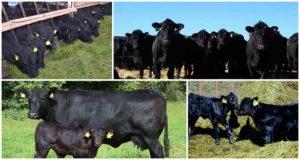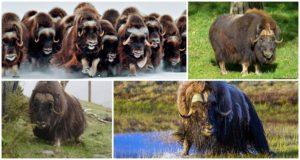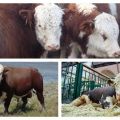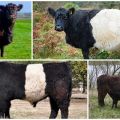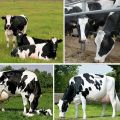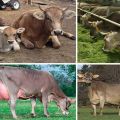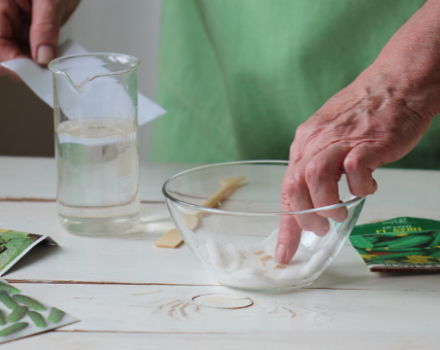Description and characteristics of Kalmyk breed cows, rules for their maintenance
The Kalmyk cattle breed is considered unique and versatile among the varieties of meat production. These are productive animals, unpretentious, long adapted to the harsh conditions of keeping. Let's consider the description and productive characteristics of the Kalmyk breed of cows, its advantages and disadvantages, as well as how to keep animals and take care of them.
The history of the emergence of Kalmyk cows
The breed was bred in the steppes of Central and Central Asia, under conditions of strict selection - the animals lived on pasture for a whole year under often unfavorable climatic conditions. This contributed to the development of unique qualities fixed in the breed, which it is valued today. Kalmyk cows have been bred for 400 years in the territory from Siberia to the Don steppes, it is believed that their ancestors are Indian individuals, which then spread throughout the Asian territory.
The exterior and characteristics of pedigree animals were developed thanks to natural selection, constant keeping in the open air, in a harsh climate, sharp temperature changes.
Description and main characteristics
Kalmyk cows tolerate the cold without any problems, they have excellent immunity, individuals grow quickly on what they find in pastures. Animals are distinguished by longevity, stamina, activity and undemandingness, strong and harmonious constitution with developed muscles.
The cattle of this steppe breed have a strong, long body. Individuals have an even back, deep chest, short neck, small head. The horns are curved, directed upwards, the legs are straight. A special breed characteristic is the occipital crest.
Kalmyk cattle have a pronounced meat orientation, therefore the udders of dairy queens are large. By the onset of winter, bulls and heifers begin to grow thick wool, so that individuals can stand outside in the cold. The main color is red, with white markings, but animals are also born red or brown and variegated. Marks appear more often on the limbs and head, less often on the body.
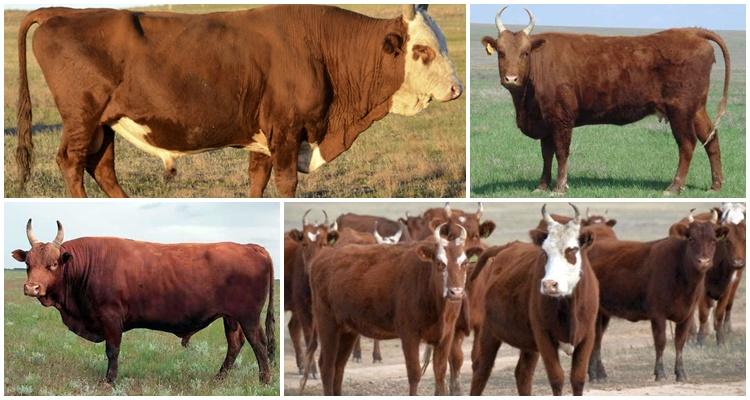
The height at the withers of bulls and cows is 140 and 130 cm, the girth behind the shoulder blades is at least 186 cm, the body length is 145-160 cm.The weight of a bull is, on average, 950 kg (up to 1100 kg), for a cow, on average, 480 kg.
The production value of the Kalmyk breed lies in their meat, which stands out for its high quality, has a delicious taste, is distinguished by a pronounced "marbling", which is appreciated by consumers. Fat is located between the layers of muscle fibers. The meat yield is, on average, 60%, maximum - 68%. Kalmyk bulls can be slaughtered at 1.5 years old, at which time they already weigh 450-550 kg. Adult males of the breed weigh at least 600 kg, bull producers can weigh up to a ton. Females weigh 400-550 kg. Daily weight gain - not less than 850-980 g.
Positive and negative sides
Cows are hardy and unpretentious, animals can be raised in any climate, do not require special conditions of keeping. Animals can gain good weight gain only on roughage, grass, which they eat in the pasture. Juveniles demonstrate survival and early maturity, feed quickly on a simple feed.
From each adult carcass, it is possible to obtain high-quality meat in a large percentage of the carcass weight, fat milk. A distinctive feature of the Kalmyk breed is the ability to accumulate fat before the onset of cold weather, which was developed in animals during the selection process.
Fat deposits in cows are found not only under the skin, but also between the muscle fibers. In winter, cows can use it as an energy reserve. Thanks to this protection, cows can easily tolerate cold and heat, sudden temperature changes, exposure to wind, rain, and quickly adapt to new conditions after driving. According to livestock breeders, only this breed has such characteristics.
Disadvantages of Kalmyk cows: low milk yield, yellow fat, which sometimes interferes with the sale of meat, possible aggressiveness of some representatives of the breed.
How to care for and maintain Kalmyk cows?
It has already been noted that the breed is distinguished by its unpretentiousness to feed, content and complex of care. Pedigree animals, unlike representatives of other species, do not require almost any care, selected food.
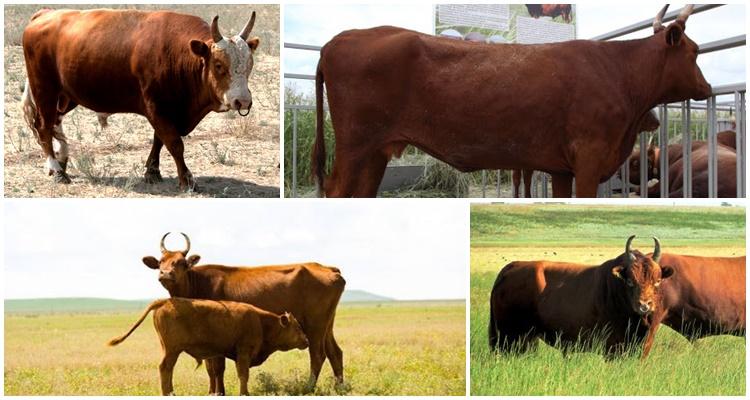
Care
Cows and bulls can live almost all year round in the pasture, they do not need to arrange special walks next to the barn. For rest, the animals are content with covered stalls, where they can stay up to 6 hours a day. Caring for cows consists of sowing herbs, caring for pastures. Even in winter, if there is not much snow, you can leave the animals in the pasture. In fenced areas, they can be grazed without the help of shepherds, which makes the maintenance extremely cheap.
Diseases and their treatment
Kalmyk cows are distinguished by good health and strong immunity. If you do not violate the rules of keeping, the cattle will not get sick. In the case of infectious or other diseases, treatment is the same as for representatives of other varieties.
Feeding
Cattle of this breed has an active developed digestive system, is able to feed almost exclusively on pasture vegetation, for example, forbs, rough grass. Animals are able to gain weight on tall grass without feeding with concentrated feed (adults - in 3-4 months, young animals - in 5 months).
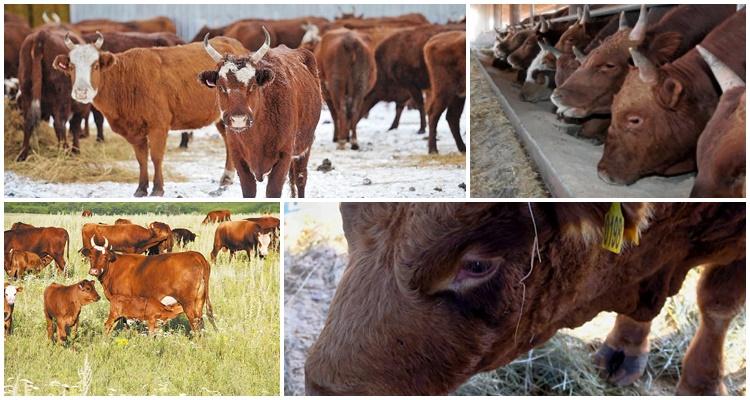
They can walk tens of kilometers in search of suitable food, tolerate winter maintenance well, and can get food from under the snow. That is, cows can be kept on free grazing, giving them only clean water: animals up to 250 kg - 35-40 liters per day, more than 350 kg of weight - 60 liters. You need to drink 3-4 times a day, more often in summer. Feed additives are required - chalk and salt. Producers are fed with hay, silage, root crops, and compound feed. Cows should rest 5-6 hours every day.
In order for the cows to be well fed, the pasture needs to be changed every week, the cattle must be returned to it in a month and a half, when the grass grows. The calves are kept together with their mothers on the sucking method, which lasts 8 months.The suckling period during the winter-spring birth of calves falls just on the grazing period, therefore, by the time of weaning, the cost of babies is minimal. Due to the low milk production, the calves drink it almost entirely, therefore, milkmaids are practically not needed for milking cows on farms.
Breeding features
The breed of Kalmyk cattle is used to improve other varieties and to obtain new meat breeds. The breed itself is also being improved, selecting the best representatives for breeding. The most valuable qualities of the breed are unpretentiousness, early maturity, rapid weight gain. When bulls are used as improvers, qualities are passed on to offspring, which allows you to get high-quality offspring from cows of other breeds.
Calves are left with their mothers before weaning, some females may show aggressiveness towards humans, protecting the calf. The cows are fertile, 89-95 calves appear for every hundred queens. By 8 months of age, they can weigh 180 kg (heifers) and 240 kg (bulls). Then they are sent for rearing and fattening, at 1.5 years they reach slaughter weight. According to these indicators, the Kalmyk breed meets all the requirements of beef cattle breeding. It is especially important here that cows are capable of producing many calves, which are considered the main product of beef cows, since they do not receive milk from them.
In the case of the Kalmyk breed, the production is greatly reduced in price due to the keeping of cows in the pasture, feeding with roughage.
Kalmyk cows are happily raised by farmers; the popularity of this breed is explained by the fact that the animals are able to grow quickly and gain weight, getting along with herbal food and modest care. Cattle of this breed require minimal care, do not cause problems, can live in a pasture, do not need a comfortable room.



